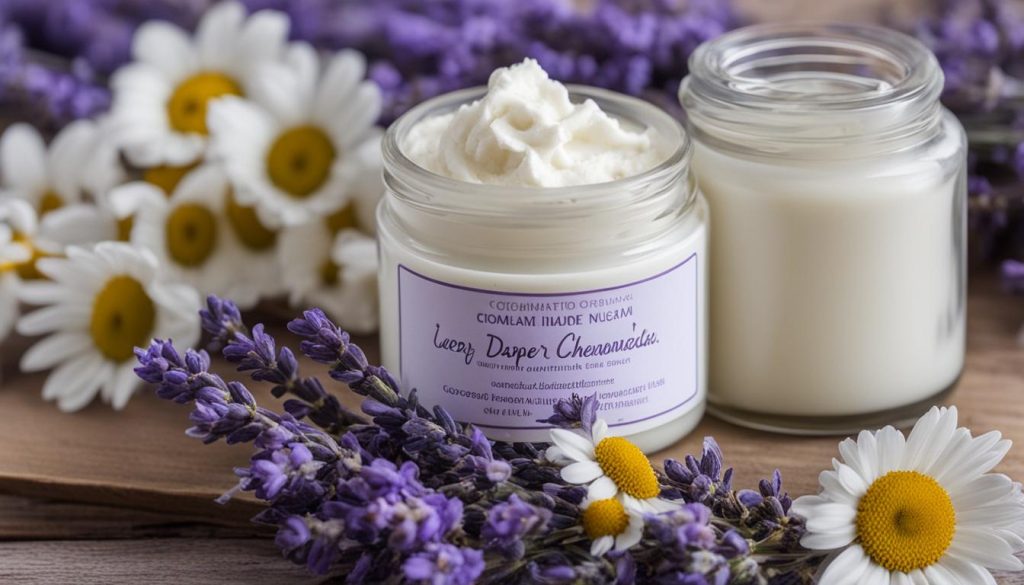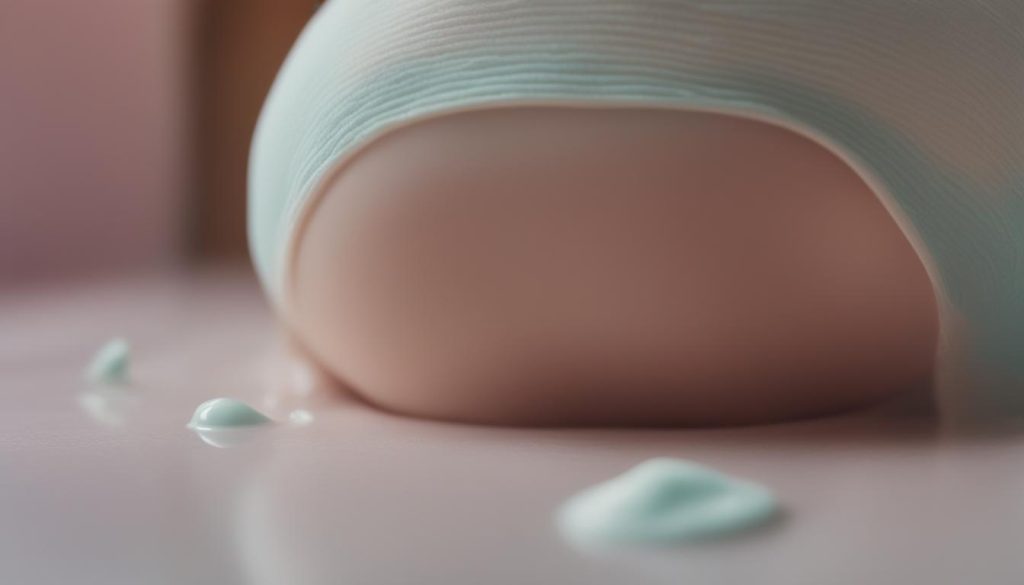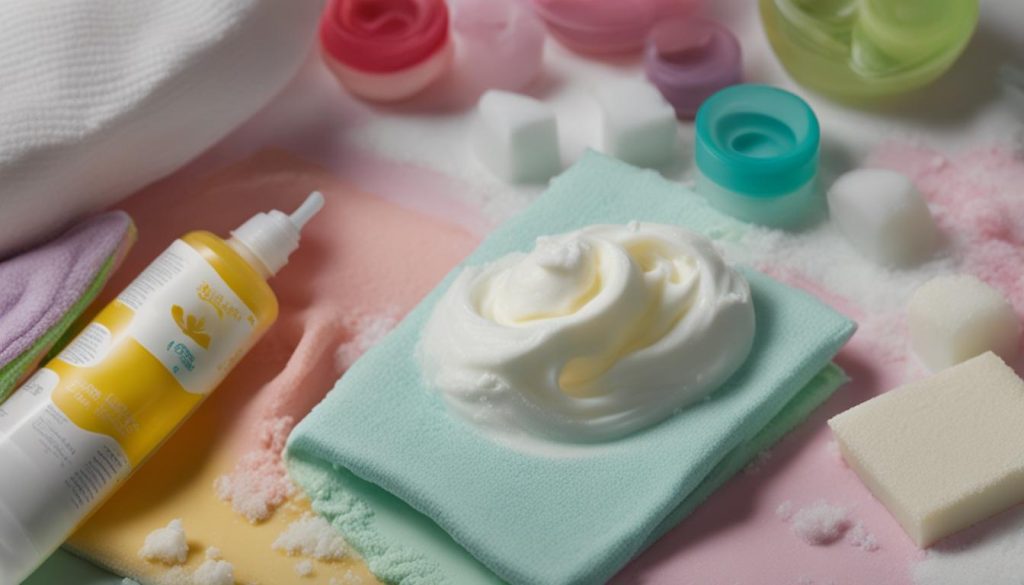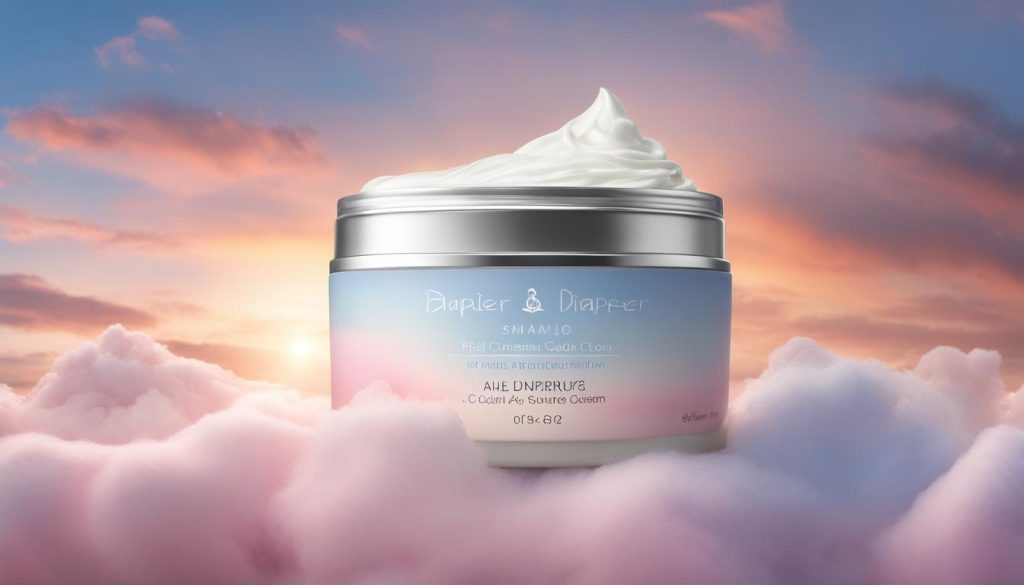Diaper rash is a common skin problem in infants, affecting between 7 and 35% of infants according to UpToDate. It can be caused by diaper use, yeast infection, allergic reaction, bacterial infection, frequent bowel movements, or diarrhea. Cloth diapers should be washed properly to remove germs. Homemade diaper rash creams can provide relief and protection for your baby’s sensitive skin.
When it comes to diaper rash, many parents are turning to homemade remedies for a safe and effective solution. Making your own diaper rash cream allows you to control the ingredients and tailor it to suit your baby’s needs. Whether you’re looking for an easy homemade diaper rash cream or the best homemade baby rash cream, DIY options provide a natural alternative to commercial products.
The Benefits of Homemade Diaper Rash Cream
When it comes to caring for your baby’s delicate skin, using natural products is always a top priority. That’s why homemade diaper rash creams have gained popularity among parents. These creams offer a range of benefits that make them a great choice for soothing and protecting your baby’s skin.
One of the main advantages of homemade diaper rash creams is that they are made from natural ingredients. Unlike commercial creams that may contain harsh chemicals, homemade creams use organic and chemical-free ingredients, ensuring that you are not exposing your baby’s skin to any potentially harmful substances. This can be especially beneficial for babies with sensitive skin or those prone to allergies.
Making your own diaper rash cream also gives you the freedom to tailor the ingredients to suit your baby’s specific needs. You can experiment with different oils, such as coconut oil or olive oil, which have moisturizing and soothing properties. You can also add natural additives like zinc oxide or essential oils, like lavender or tea tree, for their healing and antimicrobial effects. By customizing the cream, you can create a product that works best for your baby.
With the availability of DIY recipes online, making your own diaper rash cream has never been easier. These recipes provide step-by-step instructions and ingredient lists, making the process simple and straightforward. Plus, making your own cream can be a fun and rewarding experience, allowing you to take control of your baby’s skincare routine and ensure that they are getting the best possible care.
DIY Diaper Rash Cream Recipes
When it comes to caring for your baby’s sensitive skin, homemade diaper rash creams can provide a natural and effective solution. By making your own cream, you have control over the ingredients and can ensure that it is free from harmful chemicals. Here are a few easy DIY recipes to try:
Olive Oil and Shea Butter Cream
This recipe combines the moisturizing properties of olive oil and shea butter with the protective benefits of coconut oil and zinc oxide. Simply mix equal parts of olive oil, shea butter, and coconut oil, and add a teaspoon of zinc oxide powder. Blend the ingredients until smooth, and store in a clean, airtight container. Before applying, warm a small amount of the cream in your hands and gently massage onto your baby’s irritated skin.
Coconut Oil and Beeswax Cream
If you prefer a thicker consistency, this recipe with coconut oil and beeswax is a great option. In a double boiler, melt together 1/2 cup of coconut oil and 1 tablespoon of grated beeswax. Once melted, remove from heat and add a few drops of essential oils such as lavender, lemon, or tea tree for added soothing properties. Allow the mixture to cool and solidify before transferring to a container. Apply the cream as needed, gently massaging it onto your baby’s rash-prone areas.
Remember to always warm the homemade cream before applying it to your baby’s skin, as this will help with easier and smoother application. Additionally, it’s important to store the cream in a cool, dry place to maintain its consistency and efficacy.
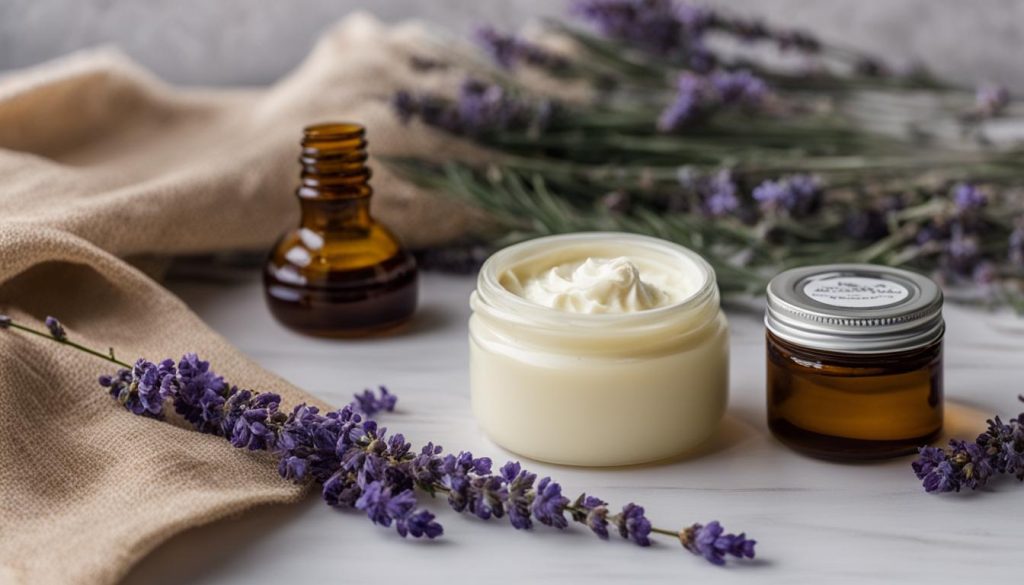
Table: DIY Diaper Rash Cream Recipes
| Ingredients | Instructions |
|---|---|
| Olive oil, shea butter, coconut oil, zinc oxide powder | Mix equal parts of olive oil, shea butter, and coconut oil. Add a teaspoon of zinc oxide powder. Blend until smooth. Store in airtight container. Warm before applying. |
| Coconut oil, beeswax, essential oils (lavender, lemon, tea tree) | Melt 1/2 cup of coconut oil and 1 tablespoon of grated beeswax in a double boiler. Remove from heat and add a few drops of essential oils. Allow to cool and solidify. Apply as needed. |
These homemade diaper rash cream recipes are not only easy to make but also offer a safe and natural alternative for soothing your baby’s delicate skin. Experiment with different ingredients and ratios to find the perfect recipe that works best for your little one. Always remember to consult your pediatrician if the rash persists or worsens.
Natural Home Remedies for Diaper Rash
When it comes to treating diaper rash, homemade diaper rash creams are a popular choice among parents. However, there are also other natural remedies that can provide relief and promote healing for your baby’s delicate skin. These remedies can be easily incorporated into your baby’s skincare routine to help prevent and manage diaper rash.
Breast Milk:
One of the simplest and most effective natural remedies for diaper rash is breast milk. The healing and anti-infective properties of breast milk can help soothe irritated skin and promote faster healing. Simply apply a few drops of breast milk to the affected area and allow it to air dry before putting on a clean diaper.
Apple Cider Vinegar:
Diluted apple cider vinegar can also be used to treat diaper rash caused by yeast infection. Mix one tablespoon of apple cider vinegar with one cup of water and use a soft cloth or cotton pad to gently cleanse the affected area. The acidic properties of apple cider vinegar help balance the pH levels of the skin and inhibit the growth of yeast.
Natural Oils:
Various natural oils have soothing and healing properties that can help alleviate diaper rash. Olive oil, coconut oil, and cornstarch can all be applied to the affected area to provide relief and protect the skin. These oils help create a barrier to prevent further irritation and lock in moisture, promoting healing.
It’s important to keep in mind that every baby’s skin is different, and what works for one may not work for another. It’s always a good idea to consult with your pediatrician before trying any new remedies. Remember to do a patch test on a small area of skin before applying any natural remedies to your baby’s diaper rash.
| Remedy | Benefits |
|---|---|
| Breast Milk | Healing and anti-infective properties |
| Apple Cider Vinegar | Helps treat yeast-caused diaper rash |
| Natural Oils | Provides soothing and protective barrier |
Preventing Diaper Rash Naturally
Preventing diaper rash is essential for your baby’s comfort and well-being. By taking simple and natural preventive measures, you can reduce the occurrence of diaper rash and keep your baby’s skin healthy. Here are some tips to help you prevent diaper rash:
- Use hypoallergenic diapers: Switching to hypoallergenic diapers that are free of harmful chemicals can minimize skin irritation and reduce the risk of diaper rash.
- Choose natural fiber wipes: Opt for natural fiber wipes that are gentle on your baby’s skin. Avoid wipes that contain alcohol, fragrance, or other potential irritants.
- Change diapers frequently: Regularly changing diapers helps to keep your baby’s skin clean and dry. Moisture and bacteria can contribute to diaper rash, so be sure to change diapers as soon as they are soiled or wet.
- Give diaper-free time: Allowing your baby to have diaper-free time can help their skin breathe and reduce the risk of diaper rash. Place a waterproof mat or towel underneath your baby during diaper-free time to catch any accidents.
- Keep the skin clean and dry: Clean your baby’s diaper area with mild soap and water during diaper changes. Pat the skin dry gently with a soft towel before applying a fresh diaper.
- Keep a food diary: If your baby is eating solid foods, keeping a food diary can help you identify potential food triggers for diaper rash. Certain foods can cause acidic or loose stools, increasing the risk of diaper rash.
- Avoid tight diapers: Ensure that your baby’s diapers are not too tight, as this can create friction and irritation. A snug but comfortable fit is best.
- Use natural skincare products: When choosing skincare products for your baby, opt for natural and gentle options. Avoid products that contain harsh chemicals, fragrances, or dyes that could irritate the skin.
By following these preventive measures, you can significantly reduce the chances of diaper rash and keep your baby’s skin healthy and comfortable.
Table: Comparison of Diaper Rash Prevention Methods
| Prevention Method | Advantages | Disadvantages |
|---|---|---|
| Switching to hypoallergenic diapers | – Minimizes skin irritation – Reduces the risk of diaper rash |
– May be more expensive – Limited availability |
| Choosing natural fiber wipes | – Gentle on baby’s skin – Chemical-free |
– May be less convenient to find – May be more expensive |
| Changing diapers frequently | – Keeps the skin clean and dry – Reduces bacteria exposure |
– Increased diaper usage – Time-consuming |
| Allowing diaper-free time | – Allows the skin to breathe – Reduces moisture buildup |
– Potential mess – Requires supervision |
| Keeping the skin clean and dry | – Prevents irritation and infection – Maintains skin health |
– Requires careful drying – Potential skin sensitivity |
| Keeping a food diary | – Identifies potential food triggers – Helps adjust diet accordingly |
– Time-consuming – Requires monitoring and record-keeping |
| Avoiding tight diapers | – Minimizes friction and irritation – Allows free movement |
– Requires proper fit adjustments – May limit diaper options |
| Using natural skincare products | – Gentle on baby’s skin – Chemical-free – Reduces the risk of irritation |
– May be more expensive – Limited availability |
Table provides a comparison of different diaper rash prevention methods, highlighting their advantages and disadvantages. It can help you make informed decisions to keep your baby’s skin protected and prevent diaper rash.
When to Seek Medical Advice
While homemade diaper rash creams and natural remedies can be effective, it is important to seek medical advice if the rash persists or becomes severe.
A doctor can evaluate the rash and determine if prescription-strength treatments such as steroids, antimicrobial creams, or oral antibiotics are necessary.
Severe diaper rash may indicate an underlying infection that requires medical intervention. It is always best to consult a healthcare professional for proper diagnosis and treatment.
FAQ
What is diaper rash?
Diaper rash is a common skin problem in infants, characterized by redness, irritation, and rash in the diaper area.
What causes diaper rash?
Diaper rash can be caused by diaper use, yeast infection, allergic reaction, bacterial infection, frequent bowel movements, or diarrhea.
Are homemade diaper rash creams safe for my baby?
Homemade diaper rash creams made from natural ingredients are safe for your baby’s skin, as they eliminate the use of chemicals that could potentially harm their sensitive skin.
Can I customize the ingredients in homemade diaper rash creams?
Yes, making your own diaper rash cream allows you to have control over the ingredients, making it possible to tailor the cream to suit your baby’s specific needs.
What are some DIY diaper rash cream recipes?
There are various DIY diaper rash cream recipes available. Some popular options include a combination of olive oil, shea butter, coconut oil, and zinc oxide, or a mixture of coconut oil, olive oil, beeswax, and essential oils like lavender, lemon, and tea tree.
Are there any natural remedies for diaper rash?
Yes, there are several natural remedies that can provide relief for diaper rash. These include applying breast milk, using diluted apple cider vinegar, using olive oil, cornstarch, coconut oil, or browned flour.
How can I prevent diaper rash naturally?
Taking preventive measures such as using hypoallergenic diapers, natural fiber wipes, changing diapers frequently, giving diaper-free time, keeping the skin clean and dry, keeping a food diary, avoiding tight diapers, and using natural skincare products can help prevent diaper rash.
When should I seek medical advice for diaper rash?
If the diaper rash persists or becomes severe, it is important to seek medical advice. A healthcare professional can evaluate the rash and determine if prescription-strength treatments or further medical intervention are necessary.

